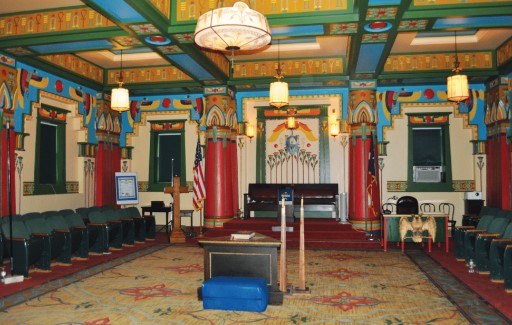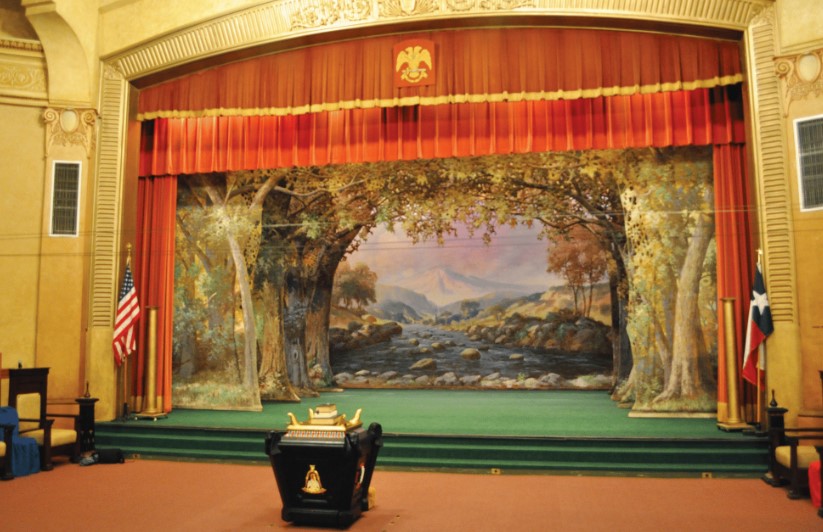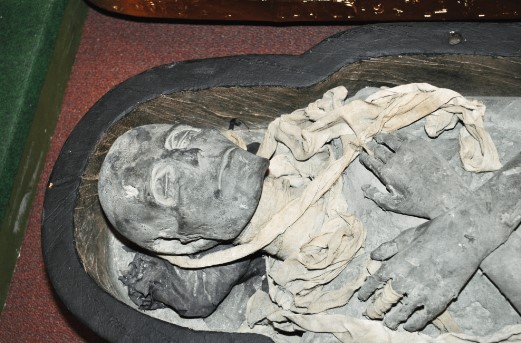Unbeknownst to many, the Island is home to a hidden treasure trove of historic theatrical scenery and props. The auditorium of the Scottish Rite Cathedral, constructed in the vaudeville era of 1929, was designed to incorporate state-of-the-art equipment of the day and scenery hand-painted by fine artists. It is a time capsule of stage history that many researchers only dream of finding intact. How such theatrical trappings became a part of the Scottish Rite Ritual traces back to 1893.
COLUMBIAN EXPOSITION
According to Historical Consultant, Scenery Restoration Specialist, and Masonic Scholar Wendy Rae Waszut-Barrett, Ph.D., the 1893 Columbian Exposition presented a turning point in how many Scottish Rites staged their degrees.
 “Three major Masonic events were held during the fair: a Masonic visitor day, the First Masonic Congress session, and the annual Supreme Council session,” shares Waszut-Barrett.
“Three major Masonic events were held during the fair: a Masonic visitor day, the First Masonic Congress session, and the annual Supreme Council session,” shares Waszut-Barrett.
Visitors from Scottish Rite Valleys from all over the world were given the opportunity to view the staged degree work performed by the Chicago’s Scottish Rite, which incorporated theatre technology and special effects into their degree work.
Theatrical manufacturers and supply companies were on display throughout the fairgrounds in Midway attractions as well, providing fraternal organizations with ideas for improved ritual experiences that could potentially draw more members. As newly inspired masons returned to their home territories with these ideas, a higher level of theatricality was woven into the membership experience.
The decision of the Scottish Rite to incorporate theatre into their rituals became a driving force in the theatrical supply industry. “You might have a local opera house that would have a stock scenery collection of maybe 10 to 40 pieces,” states Waszut-Barrett. “But then you’d have a Scottish Rite that would order between 80 and 120.“
 Their collective visit to the exposition helped to move portions of their ritual “from the lodge room floor to the elevated stage, fully incorporating the theatrical trappings of scenery, costume, lighting and stage effects,” she continues. “The Scottish Rite became the first fraternity to completely and successfully incorporate proscenium stages and auditorium seating into their meeting facilities.”
Their collective visit to the exposition helped to move portions of their ritual “from the lodge room floor to the elevated stage, fully incorporating the theatrical trappings of scenery, costume, lighting and stage effects,” she continues. “The Scottish Rite became the first fraternity to completely and successfully incorporate proscenium stages and auditorium seating into their meeting facilities.”
VALLEY OF GALVESTON
After losing their former cathedral, Harmony Hall, in a fire in 1928, the Valley of Galveston (the term used to signify the local region of Scottish Rite) was presented with the opportunity to construct a cutting edge auditorium and had the financial resources to afford the best available.
Their stage was equipped with scenery designed by the Great Western Stage Equipment Company of Kansas City, Missouri, whose emblem can still be seen stamped onto many of the backdrops. Hand-cut panels of pigment painted cotton sheeting, similar to theatrical grade muslin, were created to depict every scene required to stage the degrees of study for the Rite.
Additional “leg drops,” or dimensional layers which hung in front of the main backdrop, created a stunning illusion of depth. The same technique was used in early full-length Disney animated films.
More impressive than many local public theatres of the day, the auditorium design required 8,800 feet of guide wire; 8,800 feet of one-half inch rope; 3,000 pounds of three-sixteenths flexible steel curtain wires; 20,000 pounds of counter weights; 352 steel six-inch sheaves; 88 steel four-sheave head blocks; 468 turnbuckles; 88 steel arbors for carrying counterweights; 88 locking rails, each 3x3 feet, with automatic take-up for pull rope; 53,000 square feet of scenery canvas; and 2,200 square feet of velvet draperies.
“The end result,” touted the cathedral’s grand opening program, “is the finest stage scenery that can be found in almost any Scottish Rite Cathedral in the Southern Jurisdiction.”
Clyde Wood, a 33rd Degree Scottish Rite Master Mason and current Commander of the Knights of Kadosh, is proud of the theatre’s collection and historical significance.

“Most of these type of things are long gone, so we have to preserve what we have,” he shares. “Many of the newer Scottish Rite Valleys don’t have the kind of things we have here, because we were the first one in Texas (founded in 1867), and were a wealthy organization at that time.”
“We have 85 drops, and it takes three to five drops to create a three-dimensional scene.”
Referring to the controls backstage, Wood says, “It’s all mechanical and was state of the art for 1929. This is a vaudeville era theatre, and we can still use the original special effects. We have light boxes that project words in the sky, and big light cans that have a clockwork mechanism can make clouds go across the sky, create an inferno scene, or lava appear to flow down the side of the volcano backdrop.”
There is even a trap door on the stage used to create a surprising illusion during one of the degrees.
“I’m the stage manager, so I’m like the Wizard of Oz that makes things happen back here.” Rattling a large piece of hanging sheet metal and flashing lights, Wood explains, “This is thunder and lighting.”

“One of my favorite scenes, even though it only has three drops, is the catacomb. It looks like you can just walk through the door. The talent of the artists was amazing.” Indeed, even when one is standing merely three feet away from the painting, it appears three-dimensional.
“The five-drop forest scene is really cool, because they cut the branches and leaves out after they were painted, and backed the new openings of each drop and leg with netting.” The technique creates the illusion of looking through actual branches of trees. “Some of the effects are incredible.”
As one degree scene is changed to another to demonstrate the process, Wood calls out a series of numbers to an assistant as they lower the corresponding drops to create each set.
“We perform 29 degrees, so there are 29 sets,” Wood explains. “Some of the pieces mix and match. We also observe a couple of holidays, like Maunday Thursday (which is Holy Thursday in the Catholic community) and the Jewish Feast of Tishri, so there are some different sets for those.”
Many other Scottish Rites that once had similar theatrical collections have closed, minimized or updated their collections to the point that few in the nation can compare.
EXPERT OPINION
Waszut-Barrett, who earned her PhD in the integration of theatrical scenery in the Masonic ritual, has been studying, restoring and cataloging such collections across the United States for almost 30 years. She describes how, although many such artworks were lost from public theatres due to continual updating to keep up with trends, Scottish Rite collections often became a time capsule of sorts thanks to their tradition of rituals.
“[The scenery drops] were intended to be switched out every ten to fifteen years or so, which is why so many collections lost their original items.”
The Fort Worth Scottish Rite has updated to the point that they actually project slides of the Galveston scenery for their productions. They provided copies of these slides to Waszut-Barrett who reviewed them along with some more recent photos to assess a few of the Galveston pieces. She considers materials, color palettes, composition and technique as just a few of the clues to assist in dating the backdrops.
Theatrical rigging expert Rick Boychuck, author of Nobody Looks Up, also reviewed the photos with Waszut-Barrett, taking special interest in the counterweights and their frames.
From an initial inspection of the photos, Waszut-Barrett states, “Right now I’d say that is has scenery dating from two different eras: probably the 1920s and some replaced in the 50s. It’s very likely that some even pre-date the building. Sometimes valleys would have studios enlarge scenes to fit a new venue. It would be fair to say that the collection ranges across 30 years.”
Viewing photographs of backdrops depicting an Egyptian scene, and considering the painting style, color palette and other clues she comments, “I would be hard-pressed to date that before the 1950s.”
But the next set she considers may well be original to the cathedral.
“The forest and river scene definitely has a pre-1930s color palette and traditional look. The painting style is of an older era artist, and definitely not the same one that did the Egyptian scene.”
Quick to point out that most Scottish Rite drop collections include at least two different eras, she remains intrigued by the Galveston pieces.
“These were done by scenic artists who didn’t just work for the theatre. A lot of them were recognized as fine artists. It wasn’t just a trade, it was an art form. Many of them were studio trained and also exhibited in galleries.”
“At many of the members in Scottish Rites I’ve worked with, these are just backings, not large-scale artworks done by nationally recognized artists. They are inadvertently caretakers of huge scale art collections.”
For decades, only members of the Cathedral could see these stunning possessions, but in recent years the membership has hosted open houses and made certain rooms available to rent for special occasions.
One thing is certain: Galveston’s Scottish Rite is a beautiful treasure worthy of further study and conservation, that will hopefully be enjoyed by generations to come.
PRECIOUS PROPS
In addition to the scenery of the theatre, the Scottish Rite is home to an impressive collection of props, which are really pieces of handcrafted artwork themselves.
Kevin Thompson, who has been very active in the Scottish Rite for three years, explains that Valley member E. L. Taylor created many of the exquisite pieces used on stage during rituals in the 1920s.
“He did have a wood working company, so he was commissioned to do the props.”
“Some of the items may predate 1929,” theorizes Wood, “since many items were saved from the original building as it burned down.”
In preparation for the recent 150th Anniversary celebration, local artist Robert Dampier volunteered his time and talent to restore some of the theatrical props at the Scottish Rite.
“After Kevin showed me some of the props, I volunteered to restore them. I was happy to do that, and that they allowed me to do so,” says Dampier.
The Scottish Rite altar, which plays a significant role in the rituals, was one of the first pieces refurbished. The piece is adorned with four faces (one at each corner) and symbols representing the four bodies of the Scottish Rite.
 “I had to re-sculpt some of the facial features,” details Dampier. “I used a two-part putty that becomes hard as rock when mixed. The original piece is wood, and everything is hand-carved.” Once repairs were made, the altar was painted to replicate its original appearance.
“I had to re-sculpt some of the facial features,” details Dampier. “I used a two-part putty that becomes hard as rock when mixed. The original piece is wood, and everything is hand-carved.” Once repairs were made, the altar was painted to replicate its original appearance.
His next project was a throne-like Egyptian style wooden chair with serpent armrests.
“Each one of these serpents is hand-carved, and they are matched almost perfectly. No dremel tools or any modern help were available at the time. It’s amazing craftsmanship.”
“The colors were much more muted before restoration. The altar was kind of a dingy bronze color, and the colors were kind of pink and mint green. When choosing [the restoration] colors, I tried to stay with what they had, but also to go more vibrant.” He used the shades of old artifacts and research materials as his reference.
The piece is now finished in gleaming gold, with brilliantly colored accents and striking Swarovski crystal eyes for the serpents.
Undeniably the most unusual restoration has been a mummy in a sarcophagus, which took two weeks to complete. Though the colors and techniques used on the sarcophagus are similar to the chair, the mummy was a unique challenge.
“It’s wrapped in fabric, and the ceramic head itself looks real. There were a bunch of pock marks on his head and nose, and I had to go back and try to match the color and get everything to blend in.” Dampier adds, “He was also missing some of his fingers and toes.”
“Inside the sarcophagus was a bunch of old dust, so I collected it all, and as I painted and stained the pieces, I would rub them with the old dust and then it blended right in.” The resulting appearance is so authentic, even King Tut would be proud.
Dampier is currently applying gold leaf to a representation of the Ark of the Covenant, and after that is finished, innumerable other props are awaiting his attention.
When asked which his favorite piece to refurbish has been so far, it’s clearly a difficult decision. “I’m partial to the chair just because the carving is so beautiful. But the sarcophagus was fun.”